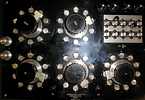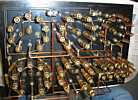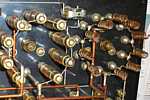Table of contents
- and the manual .pdf via
John Stuart, May 2022
- Leeds & Northrop model 4725 Wheatstone Bridge by Dave Lion, April 2012
- A further message from from Dave Lion, April 15, 2012
- Ed Thelen commented April 15, 2012
- A Bridge to the Past added January 10, 2012
6800 people & NCRy Signals people
I bought a Leeds & Northrop model 4725 wheatstone
bridge, probably made in the late 1920's or 1930's. The
unusual design, having 5 decades of 'rheostat', has 10x
the resolution of the 4-dial units. Also, the higher quality
resistors & design features give it extra accuracy.
Yesterday I started studying it. After measuring many resistors
I got the hang of changing ranges! This is unit represents the
high precision ohmmeters of its day, with few finer (excluding
equipment in electrical standards labs and the Nat'l Bureau of
Standards). Bridges having only 4 dials are the lower precision
relatives, more accurate than a Simpson 260, but slower to use.
Units like this one (with 5 decades) can routinely measure ohms
to 5 digits of accuracy and over a wider range than a Simpson.
For a low-ohm trial, I measured the low (0.1946 ohms)
resistance of the 10 amp input circuit of my Fluke DMM. Next,
I read the high (10.1 Meg) resistance of the voltmeter input.
This is my 1st time with a wheatstone bridge. I knew they were
pretty accurate but never realized what a High quality instrument
could do! I measured several dozen 1% resistors just to see the
tolerance spread... Successive parts of the same nominal value
can be read to 5 digit resolution in under 15 seconds each.
For bridge accuracy I tried some very high precision
( +- 0.01 %) resistors. Incredible! The bridge seems to be
"dead-on" accurate !
If you want a look, I have photos of the front panel & innards of
the bridge: Lots of unique, precision resistors, all with windings
done a special way, presumably for low inductance. I can send
2 or 3 interesting ones if you don't mind 3 megabyte files.
Leeds & Northrop model 4725 Wheatstone Bridge
from Dave Lion
April 2012
Fascinating !
Dave Lion
A further message from from Dave Lion, April 15, 2012
|
Answering your implied question about galvanometers:
The bridge I have is designed for desktop use where the separate elements of the working bridge are connected as needed: the power supply, the galvanometer, the the bridge itself and in some cases, a temperature controlled oil bath (as needed for ultimate accuracy). All I have is the bridge, minus its original protectine wooden cover. The model 4720 is not set up for using an oil bath, os it is 'semi-portable'.
I do also have a couple of 'modern' galvos (vintage 1960's). I am not sure either one still works. Other forms of the same model 4725 bridge were assembled into a portable wooden box with leather handle. Those boxes included a 4.5 volt battery of D-cells and a somewhat ruggedized galvo, but still retain the terminals for an external battery and galvo. Small, 4-decade portables are very common. Even brand new ones from China! One always must watch out for corroded batteries still inside the box! |
Ed Thelen commented April 15, 2012
Precision measurements do not seem so important today,
in a funny sort of way -
like do you really care if a semiconductor feature size is
29 or 30 microns or nanometers or angstroms or ????
heck - that is beyond my scope of activities -
But, say in say 1950s Nike missile guidance where your error budget
might be 10 meters at 75 miles referenced between
two radars
- one radar tracking the target
- another radar tracking the missile hopefully to the target
a certain amount of precision or low relative errors is required.
Until the 1974 retrofit, all the conversion from say physical angle
to angular voltage, to Cartesian co-ordinates, ...
was analog - with lots of closely matched resistors !!!
http://ed-thelen.org/computer.html
with analog inputs from
http://ed-thelen.org/ifc_track.html
The matched resistors for each circuit were in aluminum cans,
to help hold their temperatures as closely identical as practical -
We had a precision resistance measuring/comparing unit with a galvanometer.
It seems related to your bridge -
Fortunately, we never had to use it
- any troubles we had were much less exotic.
|
Dave Lion added January 10, 2012
A Bridge to the PastWhat is this wooden box, so blocky and heavy? Certainly not attractively sleek. There's a Funky looking, dry leather strap for a handle. There are four nice rubber feet attached with screws to the bottom. Oh, wait, another 4 feet are on one side of the box! Who designed this? I open the lid. The stuff inside is rather pretty! A whole lot of shiny black knobs populate the very shiny black panel. Actually, only 5 big knobs, but really impressively shiny. They all tower about an inch above the top panel surface and demand one's attention as if they might embody the primary man-machine interface with the Box and its functions. The shape of these knobs obviously offers a very good grip as if the knobs might only respond to significant strength and then rotate very stubbornly. To the contrary! They turn smoothly with distinct but quiet detent positions, exuding a tangible sense of high quality … or maybe precision … but, certainly high price. The only information hinting about the purpose of the box is the paper stapled to the inside of the wooden lid: "DIRECTIONS FOR OPERATING L&N NO. 5305 TEST SET". So, the box is a "test set". But WHAT does it DO? Time to get the feel of the thing. Interesting: the four similar control knobs turn fully around and each knob has two sets of brilliant white digits, 0 through 9, on each half circle of rotation. The fifth unique knob carries the revealing label: "MULTIPLY BY", and its 7 designated positions are marked in white by powers of 10 as follows: .001, .01, .1, 1, 10, 100, 1000. Sure looks like a "range" switch. There is a small, funky looking meter with a needle apparently having a smallish arc of motion above the "zero-center" scale. However, the needle seems stuck solid. Surprisingly, the scale has 30 fine graduation marks spaced closer than the broad width of the needle. That seems like a mis-match. The whole meter seems to be fastened to the panel by just two screws. Less obvious than the large knobs are 7 more, much smaller, and knurled for good grip. The knobs top off 7 obvious electrical terminals having just this sparse labeling on the panel: "Rh." "BA" "GA" "X1" and "X2". Two of the labels don't even seem to clearly relate to any particular terminals! The last significant but obscure thing on the panel is a small knob with an arrow on top and panel designations of "IN" "BA" and "OUT". It rotates easily and can also be depressed. The "DIRECTIONS" card mentions an internal battery. Sure enough, there's a metal sign on the left side of the box instructing, "REMOVE THIS PLATE …". Removal reveals a set of D-cells which were obviously installed decades ago, but strangely show only slight signs of corrosive leakage. Fortunately there is no metal within reach of the now dry crystals and those only slightly stain the inside of the wooden box. Next time I hope to share what I learn from reading the copious text on the 6 x 9 inch directions card. New batteries are called for. |


